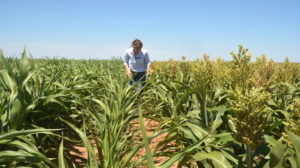Resistant varieties, beneficial predators can help producers win sugarcane aphid battle
Writer: Kay Ledbetter, 806-677-5608, [email protected]
Contact: Dr. Ada Szczepaniec, 806-354-5806, [email protected]
AMARILLO – While sugarcane aphids have been difficult to suppress in past years due to their natural traits and limited insecticide options, a Texas A&M AgriLife Research study shows resistant sorghum varieties and beneficial predators could provide a solution.

Dr. Ada Szczepaniec, AgriLife Research entomologist at Amarillo, recently authored “Interactive effects of crop variety, insecticide seed treatment, and planting date on population dynamics of sugarcane aphid and their predators in late-colonized sorghum” in the Crop Protection journal. The full article can be found at https://bit.ly/2IknvD4.
This research demonstrates that a commercially available resistant sorghum variety provides an adequate protection against this pest in the central High Plains. It also shows aphid predators already present are readily attracted to aphid-infested sorghum, Szczepaniec said.
This research was supported by funding from U.S. Department of Agriculture’s National Institute of Food and Agriculture, USDA’s Agricultural Research Service, Areawide Pest Management of the Invasive Sugarcane Aphid in Grain Sorghum, United Sorghum Checkoff and Texas Grain Sorghum Producers Board.
Szczepaniec said biological control of aphids was significantly improved on the resistant sorghum with a combined top-down and bottom-up control approach.

Currently, sorghum fields require weekly inspection for sugarcane aphids with scouting efforts intensified to twice weekly once they are detected to ensure timely insecticide applications, she said. Insecticides are recommended at 50-125 aphids per leaf on susceptible sorghum or once 20-30 percent of plants are infested with evidence of substantial honeydew.
“Once densities exceed 500 aphids per leaf, it is difficult to suppress sugarcane aphids and, left unmanaged, they can reach densities exceeding 10,000 per plant,” Szczepaniec said.
Population size, sorghum growth stage and host plant resistance are the key determinants of the damage intensity to sorghum, which is caused by direct aphid feeding injury, she explained. By removing plant nutrients and injuring sorghum throughout its development, sugarcane aphids can decrease yield, reduce seed weight and lower grain quality.
In Szczepaniec’s study, the three-way interactions among sorghum variety, seed treatment and planting date were tested. Populations of sugarcane aphids reached outbreak densities across treatments in 2016, but their numbers were much lower in 2017.
The conventional planting date for sorghum in the Texas Panhandle is June 1, and sorghum planted in May is considered early planted. Using these timing guidelines, half of the plots were planted May 11 and May 18 in 2016 and 2017, respectively, and half were seeded June 11 and June 8 in 2016 and 2017, respectively.
Two planting dates, resistant and susceptible varieties, and treated and untreated seed were included in each plot. Individual plots were embedded within larger sorghum fields of the DKS 44-20 without seed treatment to avoid edge effects associated with smaller experimental plots. No insecticides other than the seed treatment were applied to the plots.
Szczepaniec said while the pattern of sugarcane aphid population dynamics and timing of colonization differed between the two years and depended on planting date, susceptible sorghum free of the insecticide seed treatment consistently had the highest aphid densities.
Host-plant resistance emerged as the main driver of sugarcane aphid population dynamics and aphid-predator interactions in late-colonized sorghum, she said.
“While this has been demonstrated previously with university-developed lines, this is the first report demonstrating effectiveness of the commercial resistant variety of sorghum against sugarcane aphids,” Szczepaniec said.
Crop varieties resistant to arthropods have been employed in suppression of invasive aphids with significant success in the past, she said. It is also evident sugarcane aphid populations increase extremely rapidly in late-colonizing sorghum, so early control, especially by natural enemies, is crucial to successful suppression of this pest.
“Conclusions drawn from this work are likely limited to aphid-sorghum-natural enemy interactions in post-bloom sorghum, which may differ significantly when sugarcane aphids colonize sorghum in vegetative stages,” Szczepaniec said.
Future research should examine the synergistic interaction between host-plant resistance and biological control in sorghum colonized in reproductive stages, she said. Also, predators should be integrated in the thresholds in order to improve the long-term sustainability of managing sugarcane aphids in sorghum.


